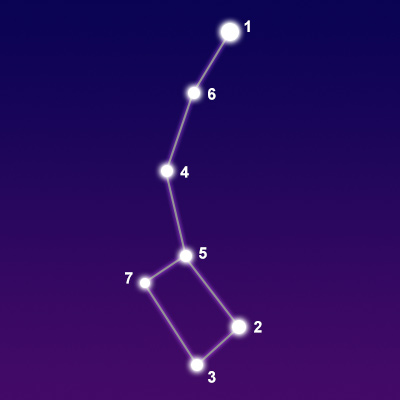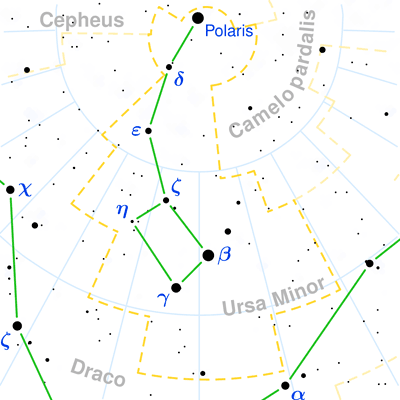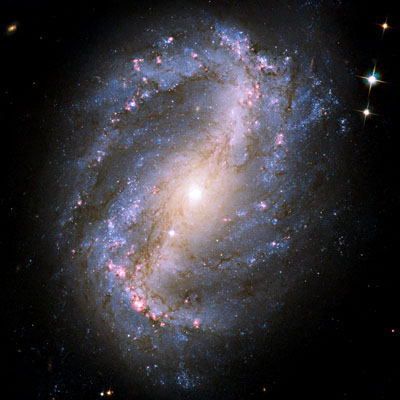Pronunciation:
(ER-suh MY-ner)Abbreviation:
UMiGenitive:
Ursae MinorisRight Ascension:
15 hoursDeclination:
70 degreesArea in Square Degrees:
256Crosses Meridian:
9 PM, June 25Visible Between Latitudes:
90 and -10 degreesThe constellation Ursa Minor, the little bear, is visible in the northern hemisphere all year long. It is a circumpolar constellation, which means it is visible all night as it rotates around the north celestial pole. It is a small constellation covering an area of 256 square degrees. It ranks 56th in size among the 88 constellations in the night sky. It is famous for a group of stars known as the Little Dipper and for Polaris, the North Star, which is located at the tip of the dipper's handle. Polaris is called the North Star because it is the closest star to the north celestial pole. This means that as the Earth rotates, Polaris appears to remain stationary in the sky while all of the other stars rotate around it. Because the Earth wobbles slightly as it rotates on its axis, Polaris will not always be the North Star. In about 14,000 years the north celestial pole will point away from Polaris and toward Vega. This process is known as procession. Polaris is an important star for navigation, allowing mariners to easily identify their latitude.
Ursa Minor is one of the 48 constellations identified by the Greek astronomer Ptolemy in the second century. Its name means “lesser bear” in Latin. It is an ancient constellation with roots in many cultures. To the ancient Babylonians it was known as the Wagon of Heaven. In Greek mythology, this constellation was associated with two different myths. In one, it represented Ida and her sister Adrasteia, the nymphs who took care of Zeus on the island of Crete when he was small. Zeus rewarded them by placing them in the heavens. In another story, it represented Arcas, who was the son of Zeus and the nymph Callisto. Arcas and his mother were transformed into bears and placed in the night sky.

points of interest below © Sea and Sky

© Torsten Bronger CC BY-SA 3.0
Kocab
Pherkad
Epsilon Ursae Minoris
Akhfa al Farkadain
Yildun
Anwar al Farkadain
"The Star"
"Calf"
N/A
"The Dimmer Calf"
"Star"
"The Brighter Calf"
Orange Giant Star
Yellow-White Giant Star
Triple Star System
White Dwarf Star
Blue-White Subgiant Star
Yellow-White Dwarf Star
2.08
3.05
4.21
4.32
4.35
4.95
Ursa Minor contains only 3 stars brighter than magnitude 4. Polaris, the North Star, is the brightest with a visual magnitude of 1.98. It is a multiple star system that contains at least three individual stars. It is located about 434 light years from Earth. The second brightest star in the constellation is Kocab with a magnitude of 2.08. It is an orange giant star that lies about 130 light years from our solar system. Pherkad is the third brightest star with a magnitude of 3.05. It is a yellow-white giant star located approximately 487 light years away.
Ursa Minor contains no Messier objects. It does, however, contain a few interesting deeps-sky objects. These include a barred spiral galaxy known as NGC 6217, a dwarf spheroidal galaxy called the Ursa Minor Dwarf, and an active supergiant elliptical radio galaxy known as NGC 6251. These objects are extremely dim and can only be seen in large telescopes.

the Hubble Space Telescope



